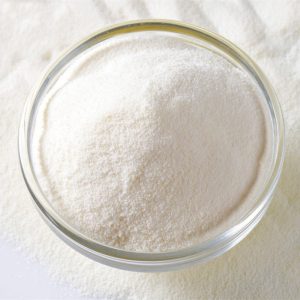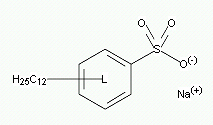
Sodium Alkyl Benzene Sulfonate LAS

Specifications
| Item | Type 30 | Type 40 | Type 50 | Type 60 | Type 70 | Type 80 | Type 85 | Type 90 |
| Active Matter % | 30±2 | 40±2 | 50±2 | 60±2 | 70±2 | 80±2 | 85±2 | 90±3 |
| Unsaponifiable Matter | ≥0.18 | ≥0.18 | ≥0.18 | ≥0.18 | ≥0.18 | ≥0.18 | ≥0.18 | ≥0.18 |
| Moisture % | ≤5 | ≤5 | ≤5 | ≤5 | ≤5 | ≤5 | ≤5 | ≤3 |
| PH(with a concentration | 7.0-11.5 | 7.0-11.5 | 7.0-11.5 | 7.0-11.5 | 7.0-11.5 | 7.0-11.5 | 7.0-11.5 | 8-10.0 |
| Appearance | White or yellowish flowing powdery particle 20-80 meshes | |||||||
Packing & Storage
| Packing | in 12.5kg bag (LAS30-LAS80), in 10kg bag(LAS85, LAS90) |
| Storage | 20℃, 2 years. |
| Shipping | Room temperature in China; may vary elsewhere |
Free Quote
At present, the company has more than 10 experienced export sales .
For samples, pricing, or more information, please call us at 0086-25-52397805 or mail to info@ascent-chem.com or we will respond to you as soon as possible.
Tel: 0086-25-52397805
E-mail: info@ascent-chem.com

General Information
| Common Names | Sodium Dodecyl Benzene Sulphonate | Sodium Alkyl Benzene Sulfonate | LAS | SDBS | ||||||
| Structure |  |
||||||
| CAS No. | 25155-30-0 | Boiling Point (℃) | N/A | ||||
| Molecular Weight | 348.476 | Melting Point (℃) | N/A | ||||
| Appearance | White or yellowish powder/granule | Vapor Specific Gravity | N/A | ||||
| HS Code | 34021100 | Flash Point (℃) | N/A | ||||
| Solubility | Soluble in water | Autoignition Temperature (℃) | N/A | ||||
| Safety Phrases | |||
| RIDADR | |||
| WGK Germany | |||
| Packaging Group | |||
| Hazard Class | |||
| SYMPTOMS | PREVENTION | FIRST AID | |
| Inhalation | Cough. Sore throat. | Use local exhaust or breathing protection. | Fresh air, rest. |
| Skin | Redness. Burning sensation. Itching. | Protective gloves. | Remove contaminated clothes. Rinse and then wash skin with water and soap. |
| Eyes | Redness. Pain. | Wear safety goggles. | First rinse with plenty of water for several minutes (remove contact lenses if easily possible), then refer for medical attention. |
| Ingestion | Abdominal pain. Nausea. Vomiting. | Do not eat, drink, or smoke during work. Wash hands before eating. | Rinse mouth. Induce vomiting (ONLY IN CONSCIOUS PERSONS!). Refer for medical attention . |
DDBSA–Acid-alkali neutralization–Slurry preparation–Slurry processing–Spray drying–Cooling aging–Finished packaging–Finished products
Frequently Asked Questions
Q: What is the performance?
A: It is an anionic surfactant. Due to its low production cost and good performance, it is widely used and is the largest synthetic surfactant used in household detergents. It also produces some inorganic salts such as magnesium and calcium and organic amine salts such as triethanolamine. Calcium dodecyl benzene sulfonate has excellent emulsifying properties and is an important part of the mixed emulsifiers used in the preparation of various pesticides. It can be condensed by benzene and α-olefin under the catalyst of aluminum trichloride, and the condensate is washed with alkali and water, then evaporated to recover benzene, and then vacuum distilled to obtain refined alkyl benzene. Then use fuming sulfuric acid for sulfonation and white ash neutralization (in 2 times the amount of ethanol) to obtain calcium dodecyl benzene sulfonate. Anionic emulsifier for acrylate emulsion polymerization. Sodium alkylbenzene sulfonate is a yellow oil, which can form hexagonal or rhombohedral strong flaky crystals after purification. It is slightly toxic and has been identified as a safe chemical raw material by international safety organizations, and can be used in fruit and tableware cleaning. Sodium alkyl benzene sulfonate is used in the largest amount in detergents, and its price is low due to the large-scale automated production. Sodium alkyl benzene sulfonate used in detergents has two types: branched chain structure (ABS) and linear chain structure (LAS). The branched chain structure has low biodegradability and will pollute the environment, while the linear structure is easy to biodegrade. , The biodegradability can be greater than 90%, and the degree of environmental pollution is small. Sodium alkyl benzene sulfonate is neutral and sensitive to water hardness.
Q: What is Sodium Alkyl benzene Sulfonate used for?
A: It is easy to oxidize, has strong foaming power, high detergency, is easy to compound with various additives, has low cost, mature synthesis technology, and wide application fields. It is an excellent anionic surfactant.Sodium Alkyl benzene Sulfonate has a significant decontamination effect on granular dirt, protein dirt and oily dirt, especially for granular dirt on natural fibers, and the detergency increases with the increase of washing temperature. The effect is higher than that of non-ionic surfactants, and the foam is rich. However, sodium alkyl benzene sulfonate has two disadvantages. One is poor resistance to hard water, and the decontamination performance can be reduced with the hardness of water. Therefore, detergents based on it as the main active agent must be used with an appropriate amount of chelating agent. The second is that the degreasing power is strong, and it is irritating to the skin when washing by hand, and the clothes feel poor after washing. It is advisable to use cationic surfactants as softeners for rinsing. In order to obtain a better comprehensive cleaning effect, LAS is often used in combination with non-ionic surfactants such as AEO. The main purpose of LAS is to prepare various types of liquid, powder, and granular detergents, cleaners, and cleaners. Because sodium alkyl benzene sulfonate has the properties of decontamination, wetting, foaming, emulsification, and dispersion. Its biodegradability is >90%, so it can be directly used to prepare civil and industrial cleaning products. Such as ordinary (phosphorus-free) washing powder, concentrated (phosphorus-free) washing powder, solid detergent, slurry detergent, paste detergent. Cleaning agent and dyeing auxiliaries in the textile industry, degreasing agents in the electroplating industry, deinking agents in the paper industry, fertilizer product additives, and other industrial cleaning agents, emulsifiers, dispersants, etc.

